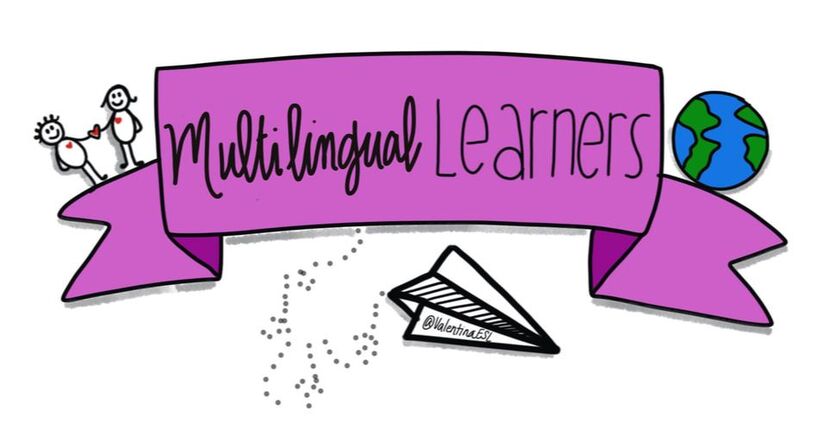18 ways to Support English Learners in your classroom in 2018 (or EVER!)2018 is going to be a year where your English Learners thrive! Your ELs need some extra scaffolds and supports to level the playing field. They are learning a new language while navigating content at the same time. Here are 18 ways that you can help support them with their journey. Not every EL will need all of these scaffolds. Some will need more than others. And once they no longer need the scaffold, remember to release it and let them soar! 1. Provide visual supports
Visual supports can be sketches that you create yourself on the fly or they can be google images that you pull up on a device when you realize that a student needs to see what you are discussing. Visuals also include real objects (realia) that you or students bring in to support vocabulary and concept development. Not enough can be said about visuals. One of my favorite ways to use visuals to support ELs is through Picture Talks or the Picture Induction Method. Learn more by clicking on the link. They are super powerful! 2. Use adapted text Some students will need adapted texts. These are texts that differ slightly from the text the native English speakers may be reading. The text is less strenuous on students who are learning English yet provide them with the same content. You can find great, FREE adapted text from websites like NEWSELA.com. Check out this blog by Larry Ferlazzo where he shares many different places to find adapted texts. What I love about adapted texts is that they look very similar to the regular text so students can’t see that anyone is getting a different form of the text. ELs don’t feel singled out and no one notices that ELs are receiving text that is different. 3. Offer sentence frames or sentence stems Sentence frames or sentence stems are an entry point into academic or social conversations for students. ELs benefit from these because they give inertia to their thoughts. I think of them like a push on a swing set. When our kids aren’t able to push themselves, we give them the initial pushes on the swing and then they take over. Sentence stems are similar. They are like a push to propel our students’ thoughts forward. A couple things to keep in mind about sentence stems/frames: we should model the use of them, offer them but not require them, and tailor stems to meet various language proficiency levels. 4. Value and encourage native language Honoring a child’s native language has many benefits both for a child’s self-esteem and academically. Language is part of who we are. Encouraging their native language sends a message that their identity is valued and respected in our classroom and world. I can remember when my sister was in the middle grades that she was embarrassed of our native language and my mom’s accent. She didn’t want her peers to see that we were different. Perhaps if one teacher would have asked questions and shown interest in her culture and language, my sister would not have stopped speaking Serbian. If a student has a language other than English that they can tap into and refer back to, we should let them! This is big. Literacy is literacy in any language. Bridging the languages helps to build the target language. 5. Provide opportunities for collaborative work Learning is social. ELs especially benefit from collaborating with other students and not just other ELs. They need to discuss, communicate, listen to, read with, negotiate, problem solve with students of all types. Groups should be fluid and flexible. Sometimes partners and other times groups. This type of setting also lowers the affective filter for ELs while allowing everyone an opportunity to participate. The old, traditional way of the classroom was that the teacher stood in front, lectured while students listened, and then the teacher asked a few questions and called on a couple of students. Only those few students who were called on actually participated, everyone else zoned out. 6. Repeat or rephrase instructions Be careful not to assume that everyone understands your directions. Many students (including ELs) will be reluctant to say in front of their peers that they don’t understand. Avoid asking, “Does everyone understand?” It’s not typical for anyone to respond, “No, I don’t understand.” Instead try gauging understanding by asking questions or having students retell the directions to a partner. Then listen in so you can clear up misconceptions by rephrasing the directions. I heard a colleague once say, “I repeated the directions at least five times and they still did it wrong.” Sometimes repeating is not enough. If they don’t understand, then repeating will not work, but perhaps rephrasing will. Try it a different way. 7. Assess understanding Check to see if students understand the lesson or directions before it’s too late. Setting students up for success is key. If we want them to do well, we have to prepare them and check along the way to see if they are on track. Some call this incremental evaluation. There are many ways to do this. It can be asking students to retell directions to a partner or having partners hold an academic conversation as you walk around and listen in. When there is a written product, check in with ELs midway to see their progress. This will help to catch problems or errors in advance or the product being turned in for a grade. If done correctly, these meetings can also be wonderful ways to build relationships with ELs. 8. Chunk academic reading materials No matter what subject you teach, there are probably reading materials that students must read. When text is lengthy, this can pose a comprehension problem for some ELs who are still processing and translating the English language. One way to alleviate this is to chunk the reading material. This means break it down into smaller pieces. ELs will still read the same text, but in between you might give stopping points to talk or sketch meaning. For example, if this blog post was an assignment for an EL that may benefit from chunking, I might chunk the reading into 3 sections and between each, my students would stop to discuss with a partner an open-ended question that I pose for them. Or I could have them read 1-9 today and 10-18 tomorrow. 9. Allow time for free reading Free reading is the best way for our students to become better readers. Read more. Read, read, read. When we assign students what they must read, they usually don’t want to read it and many of them don’t read it. But if we give them choice in their reading and the time to read, it becomes less constraining. We can’t rely on letting students read at home. That won’t always happen and we can’t control what happens at home. But what we can control is creating an environment where reading is pleasurable and inviting. We can provide daily time for our students to read. Unfortunately, since we can’t put a grade on it, many times free reading gets bumped off the daily schedule. 10. Set academic goals together Meet frequently with ELs (especially in middle grades and higher) to discuss where they are and next steps. All students need to know their target. If they don’t know where they are headed, then they may be wandering aimlessly. ELs have a lot on their plates, managing both academics and language, setting goals with them helps them to narrow the focus. If you are in a WIDA state, you can use the CAN-DO descriptors to help you set goals with your ELs. The important thing is that you confer frequently with your students, letting them know that you care about them, their success, and that you are their biggest cheerleader. This is a great time for ELs to ask you questions. If they aren’t, you can invite them to do so. Once they become comfortable enough, they will. Learn more here on personalized goal setting. 11. Intentionally plan for writing Keeping in mind that writing is not just something students do in writing class or language arts, we must intentionally plan for writing in all content areas. Why? Students need to be able to use the language of science, math, history in their writing and their speaking. One way to plan for writing in content areas is to first begin with open ended speaking activities. Having students hold academic conversations over hot topics using domain specific vocabulary can prepare them for writing. When we let them talk with several partners, they begin to hear multiple responses and can use their peers’ ideas when they begin writing. Some students will need sentence starters to help them begin their writing. Beginner ELs may need paragraph frames, picture supports and a vocabulary word bank. The point is, don’t skip the writing in content area classrooms! 12. Embed speaking opportunities I know what you might be thinking… “but they don’t talk about the topic.” That used to be my problem with letting students talk in class too. The further they were from me, the further they were from the topic. And I was frustrated because, frankly, I had a lot to cover. If I let them talk, I was afraid we wouldn’t get to all of it. AND talking is not graded, so I didn’t see the worth. But talk is CRUCIAL for our ELs. We must provide (not require) opportunities for them to discuss with a group or partner so they can negotiate for meaning, hear another’s point of view, process thinking, dig deeper, learn new vocabulary, and practice language in a low stress setting. I’ve found the best way to do this is to scaffold for success. Model what I want to see and hear EXPLICITLY, give them sentence frames and vocabulary and post the question that they will discuss so they can go back to it if they forget. Two of my favorite structured speaking methods are QSSSA and Talking Heads. Click on each to learn more. 13. Offer wait time So S.I.M.P.L.E. you don’t even have to plan for it. But you have to remember to do it. Offering wait time means that you ask a question. And then you WAIT before you call on anyone to answer. Wait. Wait. Wait. It can be awkward and someone will try to talk. Here’s where I like to throw in a twist. Rather than calling on 1 person to answer…I have them share their answers with a partner. This way EVERYONE answers rather than 1 single person. My ELs get practice talking and listening. Win, WIN! Why wait? Well, many reasons…but to begin with some of our ELs are processing and translating English into their native language. Wait time gives them a chance to do the hard work and then build the courage to answer in English too! More on wait time. 14. Embrace and lift up cultural differences We all have culture. Let’s just get that out there. The thing is that when there are differences in culture we have the choice to ignore them, embrace them or ridicule them. Many people think that ignoring cultural differences is just fine. Actually, it’s not. Cultural blindness is “acting as if cultural differences do not matter” and thinking that everyone learns the same. Our job is to embrace differences and create opportunities to learn from one another. Recognizing that each student brings with him/her unique and valuable assets that can enrich the classroom and tapping into those resources will lift up students. 15. Model what you expect When giving instructions or an assignment, model explicitly what you want to see. Your ELs will need to know what you want from them. Whether it is a writing assignment or a speaking task, show students exactly what it is that they will need to achieve. Setting students up for success from the beginning empowers them to know the goal. Some will be able to get their quickly while others will need multiple opportunities. Either way, they will all get there at some point if we model what we expect. 16. Ask questions Ask questions about their family life and about their hobbies. Don't make assumptions. Showing all students, but especially ELs, that we are interested lets them know that we care. We know that our students don’t care what we know until they know that we care. For ELs this can be so powerful since often ELs feel isolated and different. Asking questions and showing interest gives them a feeling of belonging that they may need. 17. Build a culturally responsive environment Building an environment that is culturally responsive means taking a look at the students you serve and assuring that the walls and resources reflect the students. Include books in other languages. Pull in resources that represent your student population. Your students will appreciate seeing people that resemble their families on charts, posters, books, etc. This sends a clear message that all students are welcome and valued. Including diverse materials allows each child a window and a mirror to both empathize with others and feel valued. 18. Foster an inclusive class community You set the tone in your classroom. Your students will know if you appreciate diversity and welcome students of all kinds. They will follow your lead. Fostering an inclusive classroom is paramount for ELs but really for any child. For ELs this means that we model empathy, ask questions, invite individuality, and embrace one another as we are. Inclusive classrooms allow every child to feel they have a voice. They are rooms where risk taking is appreciated and students feel safe with one another. Well, that’s definitely not everything, but it’s a start! How do you assure that ELs are supported, valued, and thrive in your classroom? Share with us!
Thanks for sharing these 18 savvy tips to help our ESL students.
Jaslyn Davies
7/27/2018 07:40:59 pm
Thank you for sharing these strategies. As I’m planning, I’m making sure to intentionally plug these in, so that I’m targeting every need for my Els. It’s all about maximizing their instructional time. Comments are closed.
|
Categories
All
|


 RSS Feed
RSS Feed
